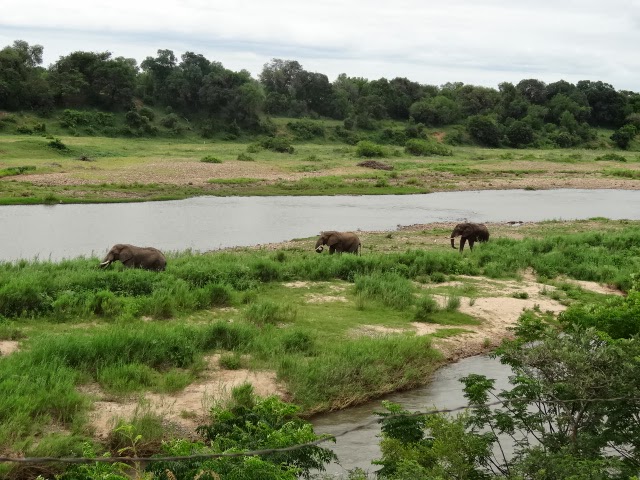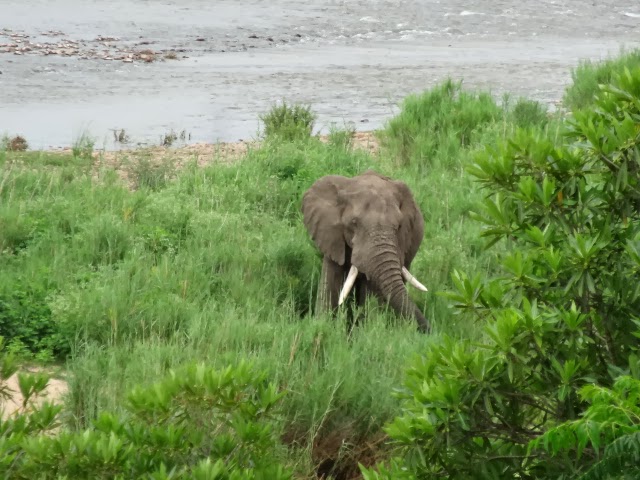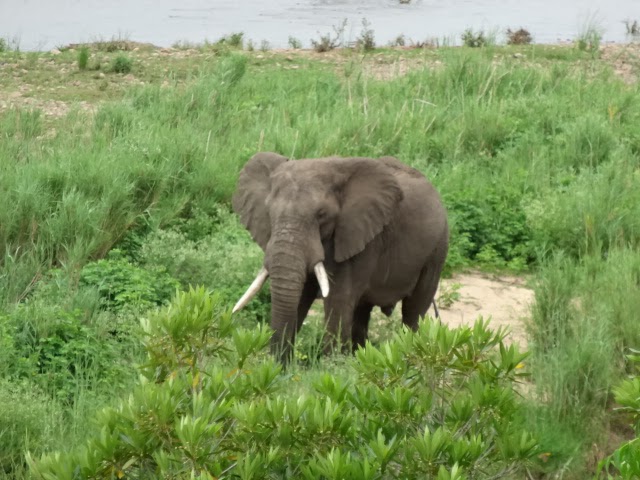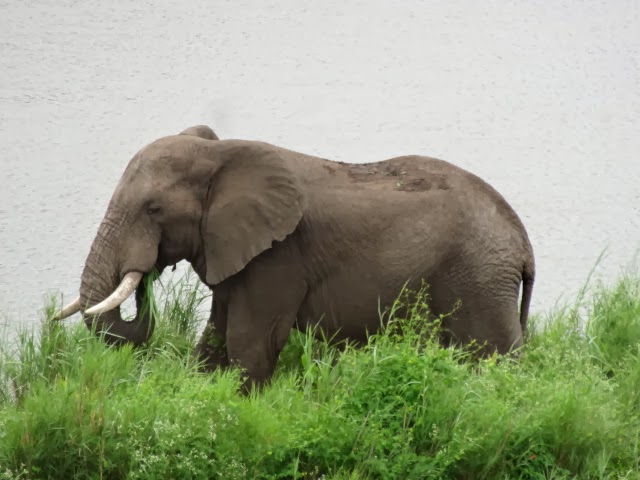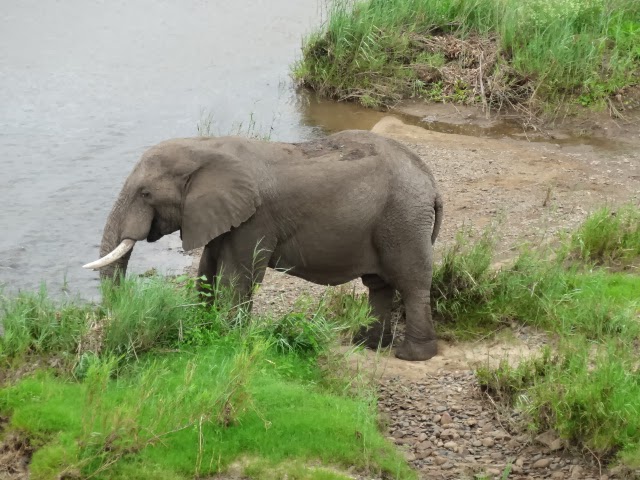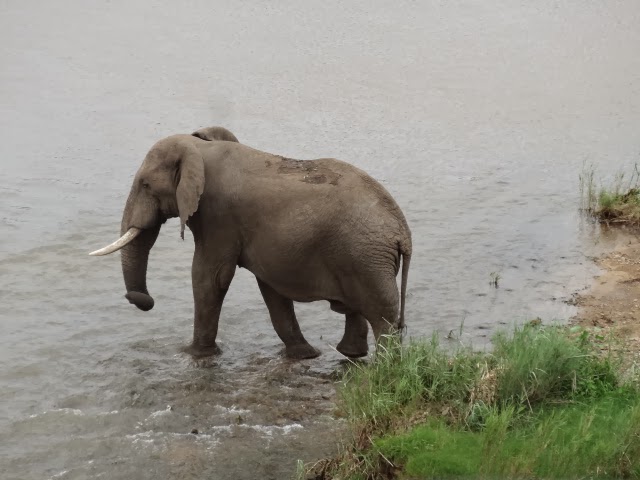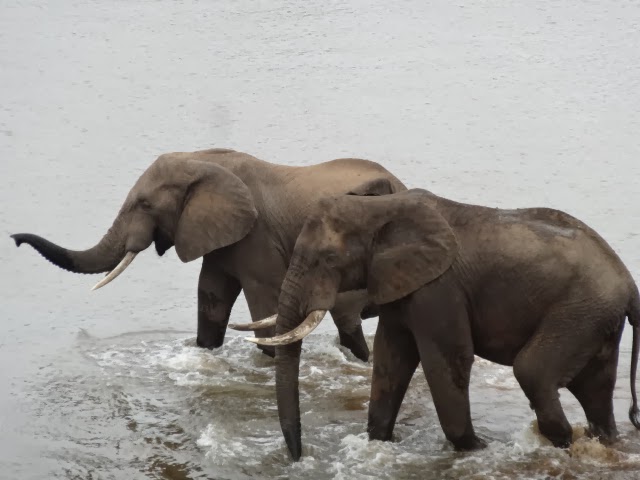 |
| This is a common sight in Marloth Park this weekend. It’s packed with tourists sitting in the back of a “bakkie” which is Afrikaans for “pick up truck.” |
“Sighting of the Day in the Bush”
 |
| Little Wart Face stopped by for a nap. |
Last night, our friends Kathy and Don, joined us for dinner at our bush home. We prepared an excellent meal without too much fuss so we could enjoy sitting on the veranda on a perfect evening, enjoying our lively conversation and the sounds of night in the bush.
On Thursday, tourists began arriving in Marloth, with many staying through Tuesday, the end of the five-day holiday weekend. The traffic has been outrageous for this conservancy. The otherwise quiet dirt road we live in is experiencing a steady stream of cars, day and night.
 |
| Midday on Friday, this was Olifant Road, the paved main road in Marloth Park. We couldn’t believe how many cars and people had entered the park for the holiday weekend. |
Kathy and Don, who live along the Crocodile River, said they’ve also seen a steady flow of traffic on their usually quiet dirt road as well. We’ll all be glad when the holiday ends.
 |
| When we took off for a drive in the park on Friday, we didn’t expect to see much and then these beautiful elephants! |
No offense intended for tourists. But, the calm and quiet residents hold in high regard is often disturbed during the busy holiday season. When Louise and Danie stopped by for a visit yesterday, they mentioned it felt like more tourists here now than there were at Easter or this past Christmas season.
 |
| A male impala in the bush. |
This is a dilemma for people who own homes here. The community needs the revenue generated by tourists staying in holiday homes and spending money in restaurants and shops. The majority of the tourists are thoughtful of the “rules of the park.” still, they can’t help but feel frustrated by a handful of tourists who play loud music, talk loudly, and are inconsiderate of the wildlife and trash disposal.
Last night, after we cleaned up (Tom did the many dishes), we wandered back outside to the veranda to see if any visitors would stop by. During the busy holiday seasons, few animals visit their usual haunts.
 |
| Several youngsters with two moms, cooling off and drinking in the Crocodile River. |
We haven’t seen Scar Face, Wart Face, or Frank since Friday, and only a few bushbucks, kudus, and the usual zillions of guinea fowl have made an appearance. This is typical when there are lots of people are in the park. Hopefully, they’ll return to their usual routine by Tuesday or Wednesday, and so will we.
 |
| One elephant was off at a distance. Could this be a male who soon will be banished from the family unit? |
In the interim, we’re staying put. Early this morning, we did a load of laundry and hung it on the clothesline. Now, as the sky has turned dark and cloudy, we may have to bring it inside before it rains. Few people have clothes dryers in South Africa, or for that matter, in many parts of the world.
Included in our rent is our fantastic Marta, who gladly will do all of our laundry. She washes and hangs up the sheets each week. In the interim, Tom and I don’t mind washing our clothes and hanging them to dry.
 |
| We will never tire of seeing elephants. They are such majestic and mysterious animals. |
Since we have so few items and only so much underwear, we do laundry more often than some. By doing it ourselves, we don’t have to wait a day or two until the next laundry day, especially for items we wear frequently.
He doesn’t like words on his clothing. I sleep in a Celebrity Cruise Line tee shirt that Tom didn’t want when it had words on it. It’s currently the only warm-weather sleepwear I own.
 |
| From this site: “Elephants may spend 12-18 hours a day feeding. Adult elephants can eat between 200-600 pounds of food a day. As herbivores, elephants consume grasses, tree foliage, bark, twigs, and other vegetation daily. Elephants can also drink up to 50 gallons of water a day about as much as a standard bathtub holds.” |
I had a wide variety of attractive sleepwear in varying colors and styles suitable for all weather conditions in our old lives. Not the case now. I wash the one tee shirt in the hopes it will dry by bedtime. If it’s too humid for it to dry (often the case), I’ll “borrow” a different tee shirt from Tom for the one night. He doesn’t mind a bit.
There’s one item of clothing I miss… a long fluffy bathrobe. A few holiday homes have had robes, but they’re often intended for much shorter people than the two of us. Wearing a robe that barely covers one’s backside is uncomfortable. We have no room in our luggage for robes, never have, never will.
 |
| Guinea fowl and zebras were snacking on pellets in the yard. |
It’s a small and insignificant sacrifice. After all these years, we give little thought to the “stuff” we had in our old lives. Sure, at times, I think that a food processor would be handy. I’m constantly chopping and dicing for our meals, and it would be so much easier with this handy kitchen appliance. In the realm of things, I guess it just isn’t that important.
With two more days until the crowd thins out and our wildlife friends return, we’ll busy ourselves with “human” friends such as Okey Dokey and her family coming for happy hour today. Louise and Danie will join us. I’d better get back in the kitchen and finish some chopping and dicing for some snacks for this afternoon when our guests arrive.
And, I see at the moment a few raindrops are falling. We’d better take the clothes off the line!
Happy day!
Photo from one year ago today, April 29, 2017:
 |
| A fancy outhouse on a tropical island. For more photos, please click here. |










































































